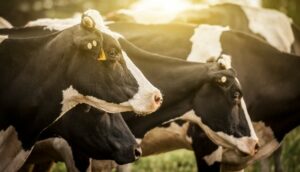Heat stress occurs when an animal is no longer able to eliminate excess body heat naturally. Under these conditions, the risk of acidosis increases.

Is the period of increased risk of “acidosis” very frequent in our farms?
Heat build-up is caused by outside temperatures and high relative humidity that exceed the physiological capacity for thermoregulation in mammals, better known as evapotranspiration. This temperature-relative humidity ratio is expressed by the THI index, which describes the levels of heat stress. Due to their high metabolic functioning, dairy cows are more subject to heat stress than humans, for example. Heat stress is considered moderate when the THI index exceeds 72 for dairy cows, while it would be over 80 for humans. The comfort temperature for a dairy cow is between 0 and 20°C. A temperature of 25°C with a relative humidity of 50% corresponds to an index of 72. Dairy cows are therefore very sensitive, which requires increased vigilance with regard to the risk of acidosis. The farmer cannot rely on his own feelings to assess the thermal comfort of his animals.
What are the consequences of heat stress on the herd?
120€ of dry loss per cow due to heat stress
The economic losses linked to heat stress are difficult to calculate. However, the findings of a study carried out on American cows showed that even if preventive measures were taken against heat stress, the losses are still around 120€/ cow/year with 80% of these losses on production and 20% on the increase in expenses linked to the health of the animal (not only due to acidosis).
Negative effects on milk production
Heat stress reduces milk yield and its components (lower fat content) and also has a negative impact on reproduction and immunity. It has also been shown that heat stress during gestation has a negative effect on lactation and consequently on productivity.
But also on the metabolic functioning that exacerbates the risk of acidosis.
The survival response of a dairy cow facing heat stress is lower dry matter intake. Indeed, fermentation in the rumen induces an exothermic reaction. This incremental heat must therefore be evacuated in addition to thermoregulation due to the high outside temperatures. There is also a positive correlation between an increase in ruminal temperature (lack of thermoregulation) and an increased risk of acidosis. The causes of rumen acidosis are as follows:
- decrease in the amount of organic matter digested,
- reduction in the production of saliva rich in buffer substances (specific glands stimulated during chewing)
- decrease in the amount of sodium bicarbonate available in the blood due to intense breathing.
In addition, there is an imbalance in the ruminal flora to the detriment of the cellulolytic flora. Feed efficiency is also affected. Heat stress therefore induces the same pathologies as chronic clinical or sub-clinical acidosis:
- medical condition is compromised,
- limping,
- fertility problems
- a higher slaughter rate.
Preventing the risk of acidosis through better herd management
Adapting the equipment
Equipment such as fans or misting systems are systematically used on dairy farms facing annual heat stress. Nowadays, farmers are familiar with this equipment and are also able to play on other criteria. But they need to operate their tools when the animals need them and not only when they too begin to suffer from heat stress.
Adapting management
Changing ration feeding times, monitoring fresh water points, or providing a more fibrous ration are common methods. Unfortunately, they are not sufficient to preserve the potential milk yield because of the double impact of the rumen: on the one hand, a lower dry matter intake and, on the other hand, a lower feed efficiency.
Reinforce natural behaviour and food intake
A combination of 2 solutions on the test bench
A study tested the combination of two sensory solutions incorporated in the feed of dairy cows subjected to a heat stress period. The first solution based on a natural extract from the Rutaceae family acts on the modulation of the stress message in the brain. The second solution, a specific blend of essential oils and spices, acts on the animal’s digestive system.
296 cows during the experiment
This experiment took place in Portugal with 296 lactating cows. Two batches of animals were formed according to the levels and stages of lactation: primiparous cows in mid-lactation and multiparous cows in early lactation. Daily milk production, feed consumption, number of animals and stage of lactation were recorded. During the test period, the average temperature at 5:00 a.m. was 17°C and the average temperature at 3:00 p.m. was 32°C. The mean temperatures during this test were higher during the supplementation period than those of the controls. Prior to supplementation, cows consumed an average of 22.7 kg of dry matter.
Behavioural outcomes
Changes in feeding behaviour were observed during the supplemented period. Cows had a higher intake in the morning when the temperature at 5:00 a.m. was higher. The effect of the first alternative is manifested by the regulation of feed intake according to environmental conditions in real time. In this trial, cows anticipated afternoon peak temperatures, especially when morning temperatures were high, by adjusting their diets accordingly. Thus, exothermic fermentations occurred mainly at times when the outside temperature was still bearable. On the other hand, supplementation had no effect on the consumption of afternoon rations because the temperatures were already too high for the cow to risk raising her body temperature even more, and to switch to acidosis!
These behavioural results, on the regulation of feed intake, are consistent with those observed during other experiments using sensory plant extracts with anti-stress virtues.
And the impact on productivity
Also in this first study, it appears that the combined use of two additives increased milk production by 0.79 L/d and 0.92 L/d in primiparous and multiparous cows respectively. This represented between 32 and 35 of the individual variability set by treatment.
The 2 solutions tested in addition gave good results on the herd despite a period of heat stress. This is therefore an interesting approach to combine with the good practices already in place to limit the consequences of acidosis during the critical heat-humidity periods experienced by our production animals.












